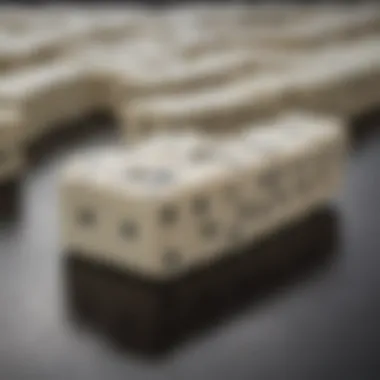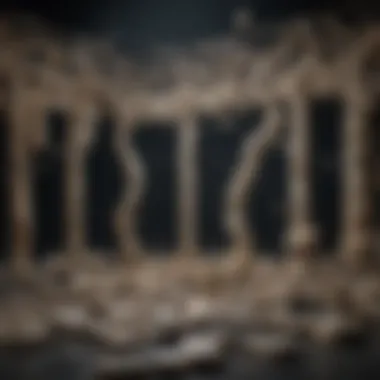Understanding the Domino Effect: Mechanics and Beyond


Intro
The act of knocking over dominoes is often viewed as a simple game or a casual pastime. However, beneath this seemingly straightforward activity lie rich scientific principles and profound implications. This article delves into the mechanics of domino toppling, aiming to enlighten readers regarding the foundational concepts of stability and energy that govern this action. By exploring the various applications in educational settings, artistic expressions, and even psychological studies, we seek to reveal the deeper significance of what at first may appear trivial.
Understanding how dominoes interact with one another provides insight into broader scientific phenomena. It also offers valuable lessons in physics, particularly concerning force, momentum, and energy transfer. As dominoes cascade in a sequence, they illustrate complex dynamics in a tangible way, highlighting fundamental concepts in mechanics that are applicable across various scientific fields.
Additionally, the seemingly simple act of a domino falling can provoke thought about human behavior and cognitive psychology. The reactions we have to watching dominoes topple can reveal much about our perception of cause and effect, making it a useful tool for research and education.
This article will dissect these themes, preparing the reader to appreciate the intricate mechanics of dominoes and the wider implications this phenomena holds across multiple disciplines.
Prolusion to Dominoes
The study of dominoes in the context of knocking over provides an intriguing lens through which we can explore fundamental physics. The mechanics involved in a simple row of dominoes set to fall one after the other are not as trivial as it may appear. Understanding these mechanics requires a closer look at concepts like stability, force, and energy transfer. This topic is essential not only for those in physics and engineering but also for educators who can utilize these concepts to engage students in hands-on learning.
The principles of domino toppling can serve as a springboard into wider discussions about dynamics, systems thinking, and even chaos theory, showcasing how a seemingly simple action leads to complex outcomes.
History and Evolution
Dominoes have a rich history that dates back to ancient China, where they were used both as a game and a tool for teaching strategic thinking. The game spread to other cultures, evolving in form and design along the way. In Europe during the 18th century, the modern double-six domino set became popular. Historically, dominoes have served multiple purposes, bridging leisure and education.
Throughout history, the evolution of dominoes reflects changes in materials and techniques. Originally made from bone or ivory, modern dominoes are typically made from plastic, allowing for wider accessibility and variety in designs.
Cultural Significance
The cultural significance of dominoes extends beyond entertainment. Many communities view the game not just as a pastime, but as a social activity that fosters communication and camaraderie. In certain cultures, domino tournaments can be a significant community event, where technique, strategy, and sometimes, local pride are at stake.
Additionally, dominoes have been used in art and expression. Artists have utilized the toppling dominoes conceptually, symbolizing themes of cause and effect. Their visual impact in sequential art encourages a deeper reflection on the interconnectedness of actions in life, making dominoes a cultural artifact that resonates across various domains.
Fundamental Principles of Domino Toppling
Understanding the fundamental principles of domino toppling is crucial for grasping the mechanics at work in this seemingly simple activity. These principles dive into the essence of stability and motion, shedding light on how dominoes interact with each other when arranged in sequences. This section will elucidate key components that govern the success of an entire domino layout, focusing on how slight changes can drastically affect the outcome. Moreover, discussing these principles also illuminates their broader implications in various fields of study such as physics, psychology, and education.
Physics of Stability
The physics of stability plays a pivotal role in the interaction of falling dominoes. Each domino's ability to stand upright or topple depends largely on its center of mass and base of support. If a domino is displaced beyond a critical angle, gravitational forces overtake its stability, leading to a fall. This tipping point is influenced by several factors:
- Height and Width: The ratio of height to width can determine how easily a domino will fall. Taller and narrower dominoes require a more precise angle to initiate toppling.
- Material Density: Heavier dominoes may have a different stability threshold compared to lighter ones. The material's density affects how it interacts with gravity.
- Placement: Even the slightest misalignment in placement can influence the sequence. A domino placed too far or too close will affect how much kinetic energy is transferred in sequence.
Understanding these physical properties can be beneficial not just for creating impressive layouts, but also for applying these concepts in educational scenarios. The relationship between stability and structure serves as a foundation for many principles taught in physics courses.
Kinetic Energy Transfer
Kinetic energy transfer is another vital component in the domino toppling mechanism. When one domino falls, it transfers its energy to the next one in line. This transfer of kinetic energy can be analyzed through these aspects:
- Speed of Fall: The speed at which the first domino falls affects the energy it transmits to subsequent dominoes. Faster momentum implies greater energy transfer, facilitating a quicker reaction.
- Distance Between Dominoes: The spacing will determine how effectively energy moves from one domino to another. Too much distance can lead to insufficient energy transfer, causing a halt in the sequence.
- Angle of Impact: The angle at which the dominoes strike one another is essential. Ideally, a straight impact maximizes energy transfer, as an oblique hit may not pass sufficient force.
"Understanding how kinetic energy moves through domino sequences allows us to explore broader concepts such as conservation of energy and motion dynamics."
By applying principles of kinetic energy transfer, both students and professionals can better grasp foundational physics concepts. The energy dynamics of falling dominoes serve as a simplified model for larger systems in motion, unifying theoretical frameworks with tangible examples in real-life scenarios.


The Domino Effect Explained
The concept of the domino effect is fundamental to understanding how a singular action can lead to a series of consequential events. In the context of dominoes, this effect exemplifies the principles of motion, stability, and energy transfer. The toppling of one domino represents more than just a playful chain reaction; it is a profound illustration of physical laws at work. Understanding the domino effect is essential because it relates to numerous fields ranging from physics to psychology. Comprehending these sequential mechanics can inform both educational practices and practical applications across various disciplines.
Mechanics of Sequential Toppling
Sequential toppling begins with the initial impulse delivered to the first domino. This impulse can be a simple push or any other force acting upon it. The important part is that the force must be sufficient to overcome the established equilibrium of each domino. When the first domino falls, it applies a force to the next, causing it to tip over. This process continues down the line, with each domino transferring kinetic energy to its neighbor.
The height and spacing of dominoes significantly influence this toppling chain reaction. Taller dominoes have more gravitational potential energy, which translates to increased kinetic energy upon falling. Additionally, the distance between each domino should be carefully calculated to ensure that the falling domino can successfully strike the next one. If the spacing is too wide, the energy may dissipate before reaching the next piece, causing an interruption in the sequence. Thus, the initial contact and subsequent reactions are crucial in sustaining the effect throughout the chain.
Role of Friction and Gravity
Friction and gravity are two primary forces that directly affect the domino effect. Gravity, as an enduring force, pulls each domino downwards. This natural force is what determines the rate at which a domino falls and influences the stability of the setup. If gravity acts uniformly, it can help ensure that each domino assists in the toppling of the next.
Friction, on the other hand, plays a dual role. While it provides the necessary grip to keep the dominoes upright before being toppled, it also resists the movement once the domino begins to fall. The friction between the domino and the surface it stands on must be accounted for. A surface with too little friction may cause premature toppling, while a surface with too much friction can inhibit the motion entirely.
The balance of these forces must be managed in designs meant to maximize the domino effect. Successful layouts will use gravity to their advantage, allowing it to facilitate the motion while keeping friction at a manageable level. Understanding these interactions will help to create setups that maintain the integrity of sequential topples, contributing to both educational insights and practical demonstrations.
"The mechanics of sequential toppling represent a captivating intersection of physics, energy transfer, and human creativity, offering diverse applications that engage both mind and imagination."
Applications of Domino Toppling
The applications of domino toppling extend beyond mere child’s play, reflecting fundamental scientific principles and artistic expression. Understanding these applications is crucial as it connects the abstract concepts of physics and psychology to real-world scenarios. By examining how domino arrangements can lead to educational benefits, inspire artistic designs, and serve as platforms for experimental demonstrations, we highlight the versatility of domino toppling.
Educational Tools in Physics
Dominoes serve as effective tools in physics education for various reasons. They illustrate important concepts in mechanics, such as force, motion, and energy transfer. When students participate in domino toppling activities, they can visualize principles that might otherwise remain abstract. For instance, when a domino falls, the transfer of kinetic energy to the next piece provides a clear example of energy conservation.
- Hands-on Learning: Students learn through active participation rather than passive observation. Building a domino chain requires planning and understanding of spatial relationships, enhancing critical thinking skills.
- Visualization of Forces: Participants experience firsthand how small forces can initiate larger movements, which is often demonstrated in lectures but less tangible in traditional settings.
Overall, implementing domino toppling in classroom activities leads to a greater engagement with physical principles, fostering a deeper understanding of the subject matter.
Artistic and Creative Designs
Dominoes also find invaluable applications in the arts. Artists have used domino arrangements to create intricate designs and performances. These artistic expressions are not just visually appealing; they also often convey deeper meanings or themes.
- Installations: Large scale domino setups can create spectacular visual displays during gallery exhibitions. Artists often use colorful domino sets that captivate audiences and spark interest in the underlying physics involved.
- Performance Art: Some artists incorporate domino toppling into live performances, where the act of knocking over dominoes transforms into a form of entertainment and artistic expression. The interplay of timing and coordination highlights the rhythm and precision required in both art and science.
Through these artistic endeavors, dominoes challenge the boundaries between science and art, showcasing how both domains can inform and enrich each other.
Experimental Physics and Demonstrations
In experimental physics, dominoes serve as a compelling method for demonstrating various scientific concepts. Researchers often utilize domino toppling to illustrate complex ideas succinctly. The straightforward mechanics of dominoes allow for effective visual demonstrations that can simplify advanced principles.
- Research Projects: Students and professionals use dominoes to explore questions about dynamics and stability. Projects may involve varying weights, spacing, or even different materials to study how these factors influence the toppling.
- Public Demonstrations: Physics demonstrations for the general public often use domino toppling as a means to engage audiences. A well-executed domino display can capture attention and make scientific concepts more accessible.
Experimental setups involving dominoes can encourage curiosity about physics, leading individuals to inquire more deeply into the mechanics governing their behavior.
Dominoes illustrate that scientific concepts are not always confined to textbooks and classrooms. Engaging with them through various applications invites a broader audience to explore physics and art.
Psychological Insights


Understanding the psychological implications of dominoes plays a significant role in appreciating their impact beyond mere physical interactions. This section delves into how individuals and groups respond to the sequential nature of falling dominoes. It connects these reactions to broader themes in psychology, such as cognitive processing and social behavior. These elements foster deeper insights into learning environments, teamwork, and even individual motivation.
Cognitive Responses to Sequential Events
Cognitive psychology explores how people perceive and engage with events that unfold in a sequential manner. When observing domino toppling, individuals often experience a heightened state of attentiveness. This phenomenon can be attributed to anticipation and expectation that each domino will affect the next. Such reactions illustrate how the brain processes cause-and-effect relationships.
Key factors include:
- Attention: Individuals tend to focus intensely on the motion. The first domino’s fall triggers an anticipation of ensuing movements.
- Memory: The short-term memory plays a role as observers recall previous sequences and predict future outcomes based on patterns.
- Emotion: Observations can evoke feelings of excitement or satisfaction, especially when the layout has an aesthetic appeal or complexity.
Research indicates that engaging with sequential events enhances cognitive understanding. For example, students can benefit from hands-on experiments with dominoes. Through this, they see physics principles in action, encouraging them to think critically about mechanics.
Behavioral Observations in Group Dynamics
The analysis of behavior in group settings offers insights into how team interactions are influenced by activities like domino toppling. When individuals engage collectively in creating a domino layout, various social dynamics emerge. Group participation cultivates cooperation and communication, fostering a sense of shared purpose.
A few observations include:
- Collaboration: Participants must agree on layout designs, which encourages discourse and collaborative decision-making.
- Feedback Mechanisms: The group quickly learns from each domino's reaction. Instances of success and failure facilitate discussions that refine future attempts.
- Social Bonding: Engaging in a shared task nurtures connections among individuals. Successful completion brings a sense of achievement, which can strengthen relationships.
"The social aspect of working on domino layouts highlights the importance of teamwork, as group members learn to appreciate each other's contributions and ideas."
Designing a Domino Layout
Creating a well-structured domino layout is crucial for ensuring the effectiveness and efficiency of the toppling process. The design phase requires careful consideration of several elements, including the choice of materials, spatial arrangements, and the overall aesthetic appeal of the domino setup. Each aspect plays a significant role in the mechanical and visual outcomes of the display.
The importance of this section lies in its ability to bridge theoretical principles with practical applications. By understanding the mechanics involved in layout design, one can effectively demonstrate the interplay between stability and kinetic energy transfer, thus enhancing both educational and artistic endeavors. The right design can impact not only the success of the domino toppling but also the experience for the observers and participants involved.
Choosing Materials for Stability
When designing a domino layout, the choice of materials is a fundamental factor that influences stability and functionality. The stability of the dominoes directly impacts how they interact with one another during the toppling sequence. Commonly used materials include wood, plastic, and ceramic. Each type offers distinct properties that affect their weight, thickness, and frictional characteristics.
- Weight: Heavier dominoes tend to be more stable, as they resist being knocked over by minor disturbances. However, if too heavy, they may not yield sufficient energy to topple neighboring pieces.
- Surface Texture: A smooth texture reduces friction, allowing dominoes to tip over easily. Conversely, a rough surface increases friction, which can slow down or prevent the toppling sequence.
- Dimensions: The height and thickness of the dominoes can influence their tipping point. Taller, thinner dominoes may be more prone to imbalance, while shorter, thicker options offer greater stability.
Selecting appropriate materials involves balancing these aspects to achieve a stable domino layout that also fulfills the artistic vision.
Spatial Arrangements for Effective Toppling
Spatial arrangements are essential in designing a domino layout that facilitates effective toppling. The positioning of each piece can determine the success of the chain reaction initiated by a single push.
Key considerations include:
- Spacing: Dominoes should be placed close enough so that the energy transfer from one to another occurs efficiently. Generally, a gap of around 1.5 times the thickness of a domino is ideal for inducing a falling effect without losing energy.
- Angle Orientation: The angle at which the dominoes are positioned can significantly affect the direction and speed of the toppling. A slight angle can create a more dramatic effect, while upright placements support traditional linear sequences.
- Patterns: Elaborate patterns, such as curves or spirals, not only enhance visual appeal but also can control the speed and flow of the collapsing structure. Carefully planning the arrangement can result in captivating sequences, captivating both participants and observers alike.
Effective design ensures the correct balance between aesthetics and functionality in a domino layout. The science behind arrangements provides a framework for successful toppling, merging art with physics.
Safety Considerations
In the exploration of dominoes and their toppling mechanics, safety considerations emerge as an essential topic. Ensuring safety can significantly enhance the experience of working with dominoes while minimizing the risks associated with unintended outcomes. This section addresses the significance of safety measures to preserve both personal safety and the integrity of the domino layout.


Preventing Accidental Toppling
Accidental toppling of dominoes can lead to unexpected outcomes, including damaged setups and potential hazards. It is essential to design domino arrangements that promote stability. To prevent accidental activation, several strategies can be implemented:
- Secure Base: Ensure a flat and stable surface where dominoes are placed. Uneven or unstable surfaces can create a risk for unwarranted falls.
- Strategic Spacing: Maintain appropriate spacing between each domino. This spacing helps manage the force applied during toppling and reduces the likelihood of a chain reaction occurring inadvertently.
- Environmental Control: Adjust the environment by minimizing disturbances. Factors such as wind or vibrations can provoke accidental toppling. Environments should be kept as controlled as practical during experiments or setups.
By carefully considering these protective measures, one can enjoy working with dominoes without the worry of unforeseen disruptions.
Handling Materials Safely
Safe handling of domino materials is crucial for a successful and enjoyable experience. Improper handling can lead to injuries or property damage. It is advisable to focus on the following aspects:
- Material Thickness: Be aware of the type and thickness of dominoes used. Thinner materials, such as cardboard dominoes, may pose a risk of bending or splintering.
- Clean and Organized Workspace: A clean workspace reduces the likelihood of accidents. Keep the area free from clutter to avoid any mishaps while arranging or adjusting the dominoes.
- Supervision for Younger Individuals: If children are involved in domino arrangements, adult supervision is vital. Educators can help teach safe practices and enforce limitations on movements around the domino setup.
"When conducting experiments with dominoes, prioritize safety to ensure a rewarding experience without negative incidents."
By following these guidelines, participants can significantly reduce potential hazards associated with dominoes. Safety considerations enhance the overall enjoyment and educational opportunity of working with this fascinating medium.
Case Studies
Case studies present an invaluable segment of research that illustrates practical applications of theoretical principles, especially in the context of dominoes and their toppling mechanisms. Understanding how dominoes function when arranged in specific ways can deepen our comprehension of stability, energy transfer, and even psychological responses to sequential events.
The examination into case studies allows for a nuanced discourse that highlights various experiments and uses of dominoes.
- Importance in Education: These examples not only serve as teaching tools but also enrich the curriculum. They show students the real-world implications of physics concepts, thereby fostering engagement.
- Behavioral Insights: Observations from these studies help to draw connections between human behaviors and physical phenomena. Analyzing how groups respond to gather domino falls enhances our understanding of social dynamics, especially in educational settings.
- Demonstrating Complex Concepts: Through these cases, complex topics such as kinetic energy transfer and effects of friction become more relatable. This can stimulate interest and curiosity among researchers and educators, prompting further exploration.
Notable Experiments Involving Dominoes
Numerous notable experiments exist that have significantly contributed to our grasp of domino dynamics. One such experiment was conducted by Lutz Horn in 1983, where he set a world record using 4,000 dominoes. This specific event showcased both the beauty and the science behind sequential toppling. As each domino falls, it creates a chain reaction. This reaction effectively showcases Newton's laws of motion in action, specifically demonstrating how energy transfers through a series of kinetic interactions.
Moreover, the scientific community has examined how height and spacing affect the toppling process. For instance, researchers found that if the height of the domino increases while keeping the base the same, the toppling speed and energy dynamics evolve. Such experiments validate the foundational principles concerning stability and energy transfer.
Innovative Uses in Education
Dominoes are not only objects for play; they have also been harnessed in educational environments. Using dominoes as a hands-on teaching tool allows educators to illustrate various physics concepts effectively.
- Conceptual Learning: They enable students to visualize and comprehend concepts such as momentum, energy transfer, and angular momentum.
- Encouraging Experimentation: By allowing students to devise their own layouts and observe the results, educators foster a spirit of inquiry and critical thinking. This process of trial and error can be very beneficial in mastering the scientific method.
- Cross-Disciplinary Applications: Beyond physics, dominoes can integrate into lessons on history, art, and design. For instance, discussing the cultural significance of dominoes can lead to rich discussions about their social impacts in various societies.
These innovative uses underscore the versatility of dominoes as tools for learning. By linking the practical to the theoretical, we open avenues for greater understanding and application of scientific knowledge.
Finale
The conclusion of this article serves to underscore the significance of understanding the mechanics and implications of dominoes, especially in the context of knocking over. This topic transcends beyond mere entertainment; it reveals principles of physics, illustrates the complexities of human cognition, and presents various applications in education and art. A comprehensive grasp of these concepts encourages more profound insights into fundamental scientific principles that govern everyday phenomena.
Summary of Findings
The exploration of dominoes has unveiled several key findings.
- Physics of Stability: The principles governing the stability of dominoes act as an accessible entry point into physical science.
- Kinetic Energy Transfer: Understanding how energy is transferred in the sequential toppling of dominoes reflects broader applications in physics and engineering.
- Psychological Implications: Investigating cognitive responses to such sequential events opens dialogues about perception and behavior in group dynamics.
- Educational Applications: The use of dominoes as an educational tool serves to demonstrate scientific concepts effectively and creatively.
Overall, the interconnected dynamics of domino arrangements not only elucidate physical laws but also engage students and researchers alike.
Future Directions for Research
The study of domino effects invites further inquiry in several areas. Future research could explore the following:
- Advanced Physics Applications: Investigations into more complex domino systems may integrate concepts of chaos theory and non-linear dynamics.
- Interdisciplinary Approaches: Examining how domino sequence impacts areas such as behavioral psychology or pedagogy can yield intriguing insights.
- Innovative Designs: Exploring new materials and designs for domino structures could enhance their stability and toppling capabilities.
- Cognitive Studies: Evaluating the psychological responses to varying arrangements could contribute valuable data to cognitive psychology.







